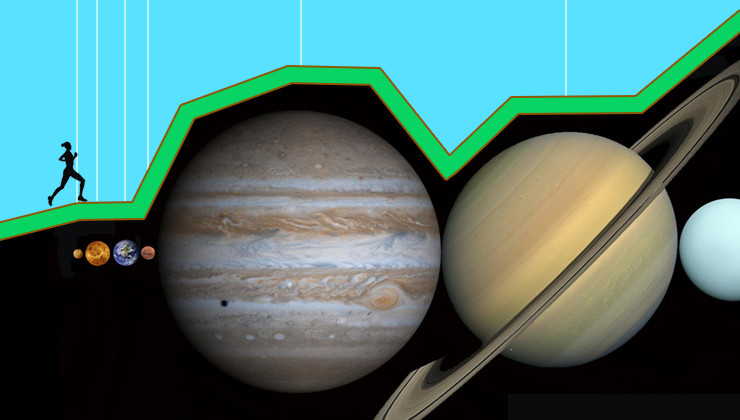Running is so boring.
That’s why you bring a phone full of music, Zombies Run episodes, and audio books. (At least you do if you’re me.) Because while running makes you feel great, reaching your mileage goal for the day, especially on a route you’ve done hundreds of times before, can leave you with a lot of contemplative airtime.
Midpoint goals can help alleviate this a lot. The other day I stumbled across this video in which a group built a 7 mile-wide scale model of the solar system. 7 miles is a pretty common distance for a lot of runners, whether they’re striving past the 10K barrier or training for a marathon.
It can take an hour or more to run 7 miles, though, so what if we alleviate that boredom a bit by running the solar system? Here’s how!
The actual distance between the planets in our solar system is vast, but is easy to scale down to whatever your mile or kilometer goal is. In the 18th century two scientists formulated the Titius-Bode Law, which hypothesized that every planet in the solar system should be twice as far from the sun as the one before it. Oddly enough, once we were able to take more accurate measurements of our solar system in the 20th century, this turned out to be roughly true, although you have to omit Earth and Neptune to really make it work.
What this means is that a runner really only has to memorize where Mercury is in their route. From there you just keep doubling the distance for every subsequent planet. So if you hit Mercury at half a mile, then that means Venus is roughly after the first mile mark, and Mars roughly after the second mile mark, Jupiter after 4 miles, and so on.
Here’s how the mileage breaks down by goal distance:
If you’re running a 5K, you hit:
Mercury @ .04 miles (224 feet)
Venus @ .08 miles (447 feet)
Earth @ .10 miles (579 feet)
Mars @ .16 miles (882 feet)
Jupiter @ .57 miles
Saturn @ 1.1 miles
Uranus @ 2.1 miles
Neptune @ 3.5 miles (This is a little bit past the 5K goal, as 5 kilometers equates to 3.11 miles.)
If your goal is to run 7 miles, you hit:
Mercury @ .08 miles (448 feet)
Venus @ .16 miles (894 feet)
Earth @ .20 miles (1158 feet)
Mars @ .33 miles (1764 feet)
Jupiter @ 1.14 miles
Saturn @ 2.2 miles
Uranus @ 4.2 miles
Neptune @ 7 miles
For a 10 mile run, you hit:
Mercury @ .12 miles (666 feet)
Venus @ .24 miles (1341 feet)
Earth @ .30 miles (1737 feet)
Mars @ .5 miles (2646 feet)
Jupiter @ 1.71 miles
Saturn @ 3.3 miles / 5K
Uranus @ 6.3 miles / 10K
Neptune @ 10.5 miles
For a marathon, you hit:
Mercury @ .32 miles
Venus @ .64 miles
Earth @ .82 miles
Mars @ 1.25 miles (For the NYC Marathon, this means you clear the rocky planets before you’re even off the Verrazano Bridge!)
Jupiter @ 4.26 miles (NYC Marathoners are still in Sunset Park.)
Saturn @ 8.24 miles (NYC Marathoners are now cutting east through Clinton Hill on their way to Bedford Ave.)
Uranus @ 15.72 miles (NYC Marathoners just conquered the Queensborough Bridge on their way into Manhattan! This is possibly the hardest part of the marathon.)
Neptune @ 26.2 miles
Pluto’s not included in these charts since its orbit is variable (sometimes it’s far out, sometimes it comes before Neptune), but if you’re running past Neptune then you’re heading into the Kuiper Belt, which holds Pluto, Makemake, Haumea, Quaoar, Varuna, Orcus, and a bunch of other dwarf planets. If you still have some energy left once you hit Neptune, you can get really crazy and run to the dwarf planet Eris, which orbits our Sun at a little over twice the distance of Neptune. (Maybe don’t attempt that after finishing a marathon! Unless you have an exoskeleton that can pick up the slack.)
So if someone asks you why you’re lacing up your running shoes, just let them know you’re running to Neptune.
If you don’t already, that is.










